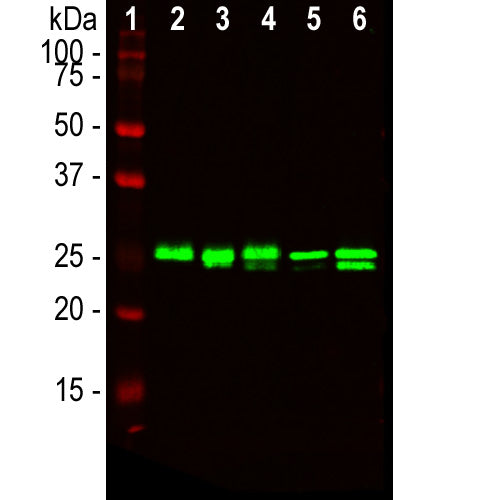
EnCor Biotechnology
Mouse Monoclonal Antibody to High Mobility Group Box Protein 1 (HMGB1), Cat# MCA-1F3
Description
The MCA-1F3 was made against the full length recombinant HMGB1 molecule expressed in and purified from E. coli. The antibody works well on western blots of cell and tissue extracts and for ICC of cell lines derived from human, rat and mouse sources. The HMGB1 protein is normally located in the nucleus where it associates with chromatin and DNA, so the antibody is a useful marker of nuclei in cell fractionation experiments.
Add a short description for this tabbed section
| Immunogen: | Human full length recombinant human HMGB1 protein expressed in and purified from E. coli. |
| HGNC Name: | HMGB1 |
| UniProt: | P09429 |
| Molecular Weight: | 25kDa |
| Host: | Mouse |
| Isotype: | IgG2b |
| Species Cross-Reactivity: | Human, Rat, Mouse |
| RRID: | AB_2572333 |
| Format: | Protein G affinity purified antibody at 1mg/mL in 50% PBS, 50% glycerol plus 5mM NaN3 |
| Applications: | WB, ICC |
| Recommended Dilutions: | WB: 1:1,000-1:2,000. ICC: 1:500-1:1,000. IF/IHC: Not Recommended |
| Storage: | Store at 4°C for short term, for longer term store at -20°C. Stable for 12 months from date of receipt. |
High-mobility group proteins were named originally since they are abundant, relatively low molecular weight and exhibit "high mobility", in other words, they run quickly on SDS-PAGE gels. High-mobility group proteins box 1 (HMGB1) is one of these. The “box” in the name refers to the so-called high mobility group box, a compact domain involved in DNA binding and protein-protein interactions. The HMGB1 molecule has two of these HMG domains (1). The protein is also called amphoterin, this name being derived from the presence of two highly charged regions in the molecule, a relatively neutrally charged N-terminus and a very negatively charged C-terminus. The molecule is very unusually charged throughout, the human sequence consisting of 16.7% Glutamic acid, 9.3% Aspartic acid, 20% Lysine and 9.3% Arginine. HMGB1 can bind toll like receptor 2, 4 and 9 (TLR2, TLR4 and TLR9) and the receptor for advanced glycation end products (RAGE), (3,4). TLRs are components of the innate immune system, first recognized as a family of receptors which recognize “pathogen associated molecular pattern" molecules or (PAMPs). These are common components of bacteria and when TLRs bind these, a strong inflammatory response is activated. More recently it has been recognized that TLRs can also be activated by "damage associated molecular pattern" molecules or (DAMPs), substances released from damaged and diseased cells which also bind to TLR family receptors and also activate inflammation. HMGB1 is such a DAMP, binding to TLR4, and much evidence suggests that HMGB1 is a strong activator of inflammation. Interestingly, HMGB1 is released by necrotic cells but not by apoptotic cells (4).
This antibody has been tested on formalin fixed and paraffin embedded samples for IHC, and is not recommended for this purpose.
1. Lotze MT, Tracey KJ. High-mobility group box 1 protein (HMGB1): nuclear weapon in the immune arsenal. Nat. Rev. Immunol.5:331-42 (2005).
2. Park J, et al. Involvement of TLR 2 and TLR 4 in Cellular Activation by High Mobility Group Box 1 protein (HMGB1). J. Biol. Chem. 27;279:7370 (2004).
3. Tian J, et al. Toll-like receptor 9–dependent activation by DNA-containing immune complexes is mediated by HMGB1 and RAGE. Nat. Immunol. :487-96 (2007).
4. Scaffidi P, Misteli T, Bianchi ME. Release of chromatin protein HMGB1 by necrotic cells triggers inflammation. Nature 418:191-5 (2002).
Add a short description for this tabbed section





